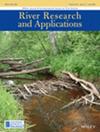从植物特征到景观的冲积生物地貌反馈:根据 A.M. Gurnell 极具影响力的贡献,从选定的法国河流中汲取经验教训
IF 1.7
4区 环境科学与生态学
Q4 ENVIRONMENTAL SCIENCES
引用次数: 0
摘要
河川生物地貌学研究的主要目的是促进我们对河岸植被与河流生态系统中河川形态动力学之间相互作用的了解。从上世纪末开始,安吉拉-M-古内尔(Angela M. Gurnell)将水流和沉积物输运与河岸植被以及后来的水生植被结合起来考虑,为河川地貌学做出了重大贡献,从而极大地推动了河川生物地貌学方法的发展。本文的目的是介绍作者和包括安吉拉-M-古内尔(Angela M. Gurnell)在内的许多合作者在过去 20 年中对法国的 Tech 河、Garonne 河、Isère 河和 Allier 河等河流进行的一系列研究和取得的成果。特别是,通过使用高分辨率遥感系统,在野外直接研究了河道形态动力学与河岸植被动态之间的反馈机制,研究范围包括单个植物、种群、群落和景观,以及在半控制的原位实验中研究单个植物。总之,作者们在过去 20 年中进行的研究有助于阐明河岸生态系统组织的最低和最高层次之间反馈动态的一些关键方面。本文对这些关键方面进行了回顾和讨论。逐步取得的成果有助于更好地理解和量化河流形态动力学与植被之间在嵌套时空尺度(从植物物种特征到河流景观)上的反馈。此外,20 多年来一直倡导的生物地貌学方法明显促进了地貌学学科向生态学,特别是进化生态学的扩展,从而有助于对地球表面过程有一个更全面的认识。本文章由计算机程序翻译,如有差异,请以英文原文为准。
Fluvial biogeomorphological feedbacks from plant traits to the landscape: Lessons from selected French rivers in line with A.M. Gurnell's influential contribution
Research in fluvial biogeomorphology largely aims to promote our understanding of the interactions between riparian vegetation and fluvial morphodynamics within riverine ecosystems. Starting at the end of the last century, Angela M. Gurnell has made a major contribution to fluvial geomorphology by considering water flow and sediment transport in combinaton with riparian and later also aquatic vegetation and thus significantly promoting the fluvial biogeomorphological approach from its early days until today. The objective of the present paper is to present a set of studies and results obtained over the last 20 years mainly by the authors and many collaborators, including Angela M. Gurnell, on a panel of French rivers: the Tech, Garonne, Isère and Allier. In particular, feedback mechanisms between fluvial morphodynamics and riparian vegetation dynamics were investigated directly in the field and by using high‐resolution remote sensor systems at the scale of individual plants, populations, communities and landscapes as well as during semi‐controlled ex‐situ experiments at the scale of individual plants. Collectively, the authors' research conducted over the past 20 years has helped to elucidate some key aspects of the feedback dynamics between the lowest and highest levels of the riparian ecosystem organization. This article reviews and discusses those key aspects. The gradually obtained results have contributed to a better understanding and quantification of feedback between river morphodynamics and vegetation at nested spatiotemporal scales, from plant species traits to the riverine landscape. Furthermore, the biogeomorphological approach advocated for more than 20 years now has clearly facilitated the extension of the discipline of geomorphology to ecology in general and evolutionary ecology in particular and thus contributed to a more integrative vision of earth surface processes.
求助全文
通过发布文献求助,成功后即可免费获取论文全文。
去求助
来源期刊

River Research and Applications
环境科学-环境科学
CiteScore
4.60
自引率
9.10%
发文量
158
审稿时长
6 months
期刊介绍:
River Research and Applications , previously published as Regulated Rivers: Research and Management (1987-2001), is an international journal dedicated to the promotion of basic and applied scientific research on rivers. The journal publishes original scientific and technical papers on biological, ecological, geomorphological, hydrological, engineering and geographical aspects related to rivers in both the developed and developing world. Papers showing how basic studies and new science can be of use in applied problems associated with river management, regulation and restoration are encouraged as is interdisciplinary research concerned directly or indirectly with river management problems.
 求助内容:
求助内容: 应助结果提醒方式:
应助结果提醒方式:


